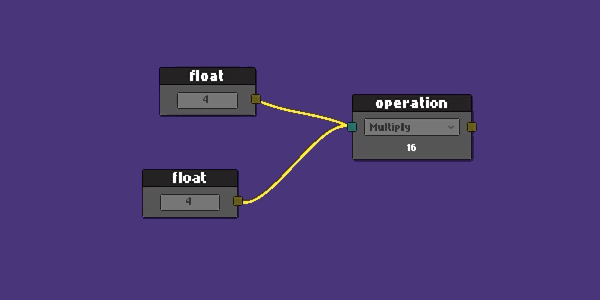Runtime Node Editor
Almost every node editor made in unity is using unity editor to make it.
My goal was make it in runtime with unity ui.
- Prefab based workflow
- Context Menu for graph, nodes and connections
- Load and save a graph using node serializer
- Pan and zoom
- Legacy and new Input System
Example
Simply extend the NodeEditor.
public class ExampleNodeEditor : NodeEditor
{
public override void StartEditor()
{
base.StartEditor();
// make your custom initialization here
}
}public class ApplicationStartup : MonoBehaviour
{
public ExampleNodeEditor editor; // asigned in unity from hierarchy
private void Start()
{
editor.StartEditor();
}
private void Update()
{
editor.UpdateEditor();
}
}Populate context menu by overriding methods below
protected override void OnGraphPointerClick(PointerEventData eventData)
{
}
protected override void OnNodePointerClick(Node node, PointerEventData eventData)
{
}
protected override void OnNodeConnectionPointerClick(string connId, PointerEventData eventData)
{
}- graph context menu
protected override void OnGraphPointerClick(PointerEventData eventData)
{
switch (eventData.button)
{
case PointerEventData.InputButton.Right:
{
var ctx = new ContextMenuBuilder()
.Add("nodes/float", CreateFloatNode)
.Add("nodes/math op", CreateMatOpNode)
.Add("graph/load", ()=>LoadGraph(_savePath))
.Add("graph/save", ()=>SaveGraph(_savePath))
.Build();
SetContextMenu(ctx);
DisplayContextMenu();
}
break;
case PointerEventData.InputButton.Left: CloseContextMenu(); break;
}
}- node context menu
protected override void OnNodePointerClick(Node node, PointerEventData eventData)
{
if (eventData.button == PointerEventData.InputButton.Right)
{
var ctx = new ContextMenuBuilder()
.Add("duplicate", () => DuplicateNode(node))
.Add("clear connections", () => ClearConnections(node))
.Add("delete", () => DeleteNode(node))
.Build();
SetContextMenu(ctx);
DisplayContextMenu();
}
}- connection context menu
protected override void OnNodeConnectionPointerClick(string connId, PointerEventData eventData)
{
if (eventData.button == PointerEventData.InputButton.Right)
{
var ctx = new ContextMenuBuilder()
.Add("clear connection", () => DisconnectConnection(connId))
.Build();
SetContextMenu(ctx);
DisplayContextMenu();
}
}Graph and nodes are all saved as prefab. Instead of handwriting graph and node visual elements, the simplest way I could find is making them a prefab and style as much as I can from the unity editor. Maintaining unityUI may get quickly overwhelming(layouts, nested rectTransforms, calculation of pointer position for nested objects, nested layout component issues, etc.)
That's been said, to create a new node:
public class MyAwesomeNode : Node
{
public TMP_InputField valueField; // added from editor
public SocketOutput outputSocket; // added from editor
public SocketInput inputSocket; // added from editor
public override void Setup()
{
Register(outputSocket);
Register(inputSocket);
SetHeader("float");
}
public override void OnSerialize(Serializer serializer)
{
// save values on graph save
serializer.Add("floatValue", valueField.text);
// it would be good idea to use JsonUtility for complex data
}
public override void OnDeserialize(Serializer serializer)
{
// load values on graph load
var value = serializer.Get("floatValue");
valueField.SetTextWithoutNotify(value);
}
}To create a node from your editor, pass its path from Resources folder.
// context item actions
private void CreateMyNode()
{
graph.Create("Prefabs/Nodes/MyAwesomeNode"); // your prefab path in resources
CloseContextMenu();
}Check out the complete expample in ExampleScene for more details.
This project is actively in development. Feel free to drop an issue for any suggestion or feedback.
LICENSE
MIT
Copyright (c) 2021 Cem Ugur Karacam

